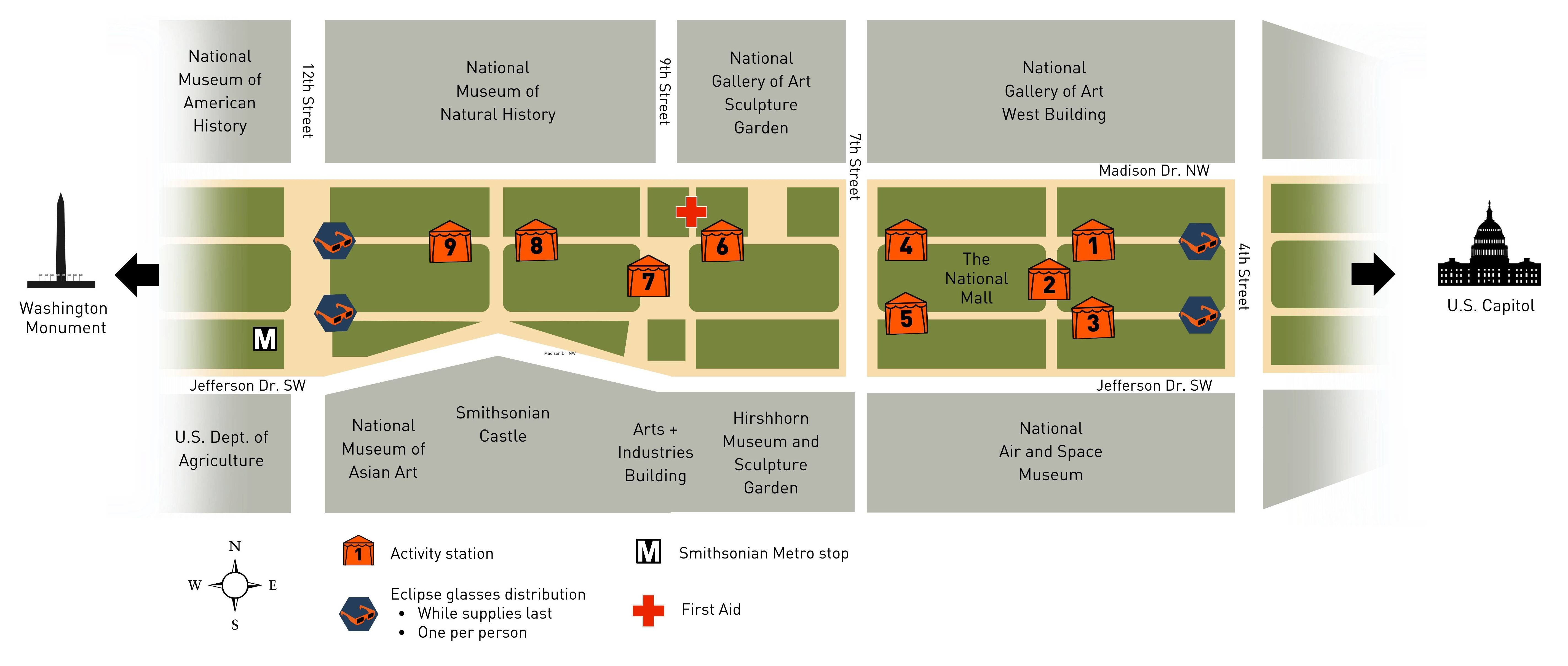Celebrate and view the solar eclipse!
Enjoy a variety of hands-on activities and observe the eclipse safely.
A limited number of eclipse glasses will be distributed between 12:00 pm and 4:00 pm while supplies last, one per person.
The eclipse will be visible from 2:04 pm to 4:32 pm. At 3:20 pm (maximum eclipse) the Moon will block 87% of the Sun.

Station 1
Predicting Eclipses
Investigate how people track solar eclipses and make a paper sundial to begin your own observations.
Presented by the National Air and Space Museum
Sunsational Structures
Explore solar-centric architectural marvels.
Presented by the National Building Museum
Station 2
Colors of the Sun
Use a prism or spectrograph to look for patterns hidden in the sunlight.
Presented by the National Air and Space Museum
Eclipse Across the Universe
Understand how the transit of planets across stars help us find planets outside our solar system.
Presented by the National Aeronautics and Space Administration
Station 3
Live View from Totality
Watch the total eclipse livestream.
Presented by the National Air and Space Museum
Speaking of the Sky
Play a game that uses Indigenous languages to describe celestial bodies.
Presented by the National Museum of the American Indian
Station 4
Multisensory Observations
Take in the eclipse with more than your eyes using tactile models and sound.
Presented by the National Air and Space Museum
Gardens of the Galaxy
Compare how plants grow on Earth and how they grow in space.
Presented by Smithsonian Gardens
Station 5
Ultraviolet Vision
Observe the Sun through a satellite's UV cameras to see solar storms.
Presented by the National Air and Space Museum
Radio Sun
Explore how radio astronomy observes our Universe.
Presented by the National Radio Astronomy Observatory
Station 6
Yardstick Eclipse Model
Make your own solar eclipse using shadows on a yardstick.
Presented by the National Air and Space Museum
Launch a Satellite into Space
Have fun learning about satellites, launches, orbits, and how NOAA fits in.
Presented by the National Oceanic and Atmospheric Administration
Station 7
Pinhole Projection Camera
Create a projection that shows the unique shadows made by the eclipse.
Presented by the National Air and Space Museum
Model the Eclipse
Create your own portable eclipse model to learn the science behind the splendor.
Presented by the U.S. National Science Foundation
Station 8
Sunlight on the National Mall
View the arc of the Sun as it moves over the Smithsonian Castle during the day.
Presented by the Smithsonian Science Education Center
Estimating Height by Hand
Learn how to use just your hands to estimate the height of the Castle.
Presented by the Smithsonian Science Education Center
Multisensory Celestial Access
Experience the sky through sound and touch.
Presented by the National Museum of Natural History
Station 9
Benjamin Banneker's 1793 Almanack
Create your own Sun art and learn about Banneker, his almanac, and African American solar scientists.
Presented by the National Museum of African American History & Culture
The Power of Sunlight
Learn about the light sensitivity of objects in NMAA's collections and test your knowledge of how materials react to light.
Presented by the National Museum of Asian Art
Sponsored by Phillip N. and Mary A. Lyons
This festival is presented by the National Air and Space Museum, the National Aeronautics and Space Administration, the National Oceanic and Atmospheric Administration, the U.S. National Science Foundation, and the National Radio Astronomy Observatory.